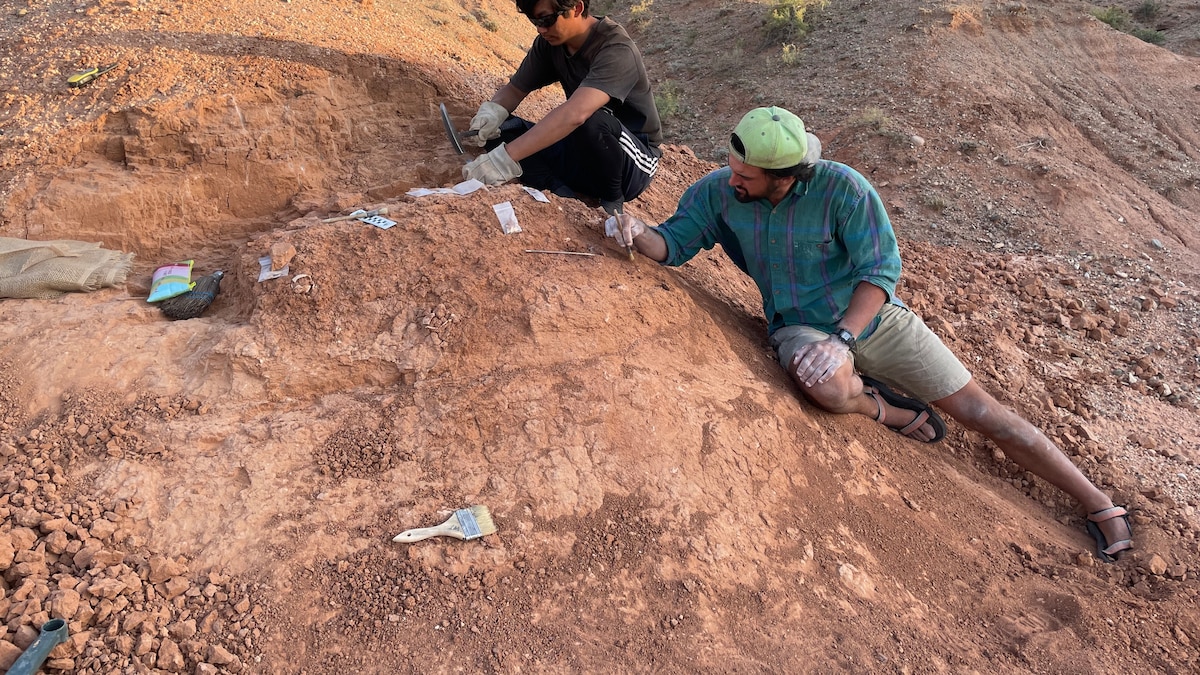Copyright National Geographic

Eggs laid by dinosaurs have provided paleontologists with a new way to tell prehistoric time. By looking to radioactive minerals taken up by eggshells in the deep past, experts have uncovered a novel method to determine when those eggs were laid—one that could put ancient ecosystems on a more accurate timeline The new research, published today in the journal Communications Earth & Environment, adds to a growing body of evidence that fossil eggshells hold mineral clues that will allow experts to date them directly. Rather than deriving the dates of fossils from the rocks in which they are encased, the study proposes that radioactive minerals like uranium in fossil eggshells can be used to directly date the fossils and refine prehistoric timelines that have previously been mysteries. (In September, a team of Chinese paleontologists announced they had dated eggs using clues in the mineral calcite contained within the fossils.) “Paleontologists excavate and study fossils so we can reconstruct the story of life on Earth, but a story without a timeline is at best nonsensical, and, at worst, misleading,” says study coauthor and North Carolina Museum of Natural Sciences paleontologist Lindsay Zanno, who is a National Geographic Explorer. Without a sense of when a prehistoric organism lived, she says, “a fossil out of context in time and space is as useful as lips on a chicken.” (How to dig up 55 tons of dinosaur bones in the world's fiercest desert) Up until now, the prehistoric timeline has been set by the rocks in which fossils are buried. When ancient volcanoes belched out molten rock and ash, for example, the outpourings of the eruptions contained radioactive minerals like uranium. Uranium turns to lead at a constant rate over time, what is sometimes referred to as its half-life, and for decades geologists have been able to look at the ratio of uranium to lead in a rock sample to calculate just how long ago that rock must have formed. The problem for paleontologists is that many fossils are found in sediments that lack these radioactive timekeepers. When an expert says a dinosaur is about 75 million years old, that usually means that their fossil was found in a rock layer in close association with a rock layer that contained something like an ash bed that could be dated correctly. Or that a fossil resembles another fossil found in such association with an ash layer. If a dinosaur fossil wasn’t found in a rock layer full of ash or solidified volcanic rocks, paleontologists could only roughly estimate the fossil’s age. The famous, well-preserved fossils of Mongolia’s Gobi Basin—dinosaurs such as the famous Velociraptor—fall into this category, their true age uncertain without a direct way to tell geologic time. “There are important dinosaur sites in North America and Asia that preserve eggshells and bones but these haven’t been accurately dated due to lack of ash layers,” says University of Calgary paleontologist Darla Zelenitsky, who was not involved in the new study. Though she cautions that “dinosaur eggshells aren’t found very often,” she notes that with uranium-lead (U-Pb) dating, “when they are [found], they could help us figure out the age of fossil sites, especially in places that don’t have volcanic ash layers.” (Is this a teen T. Rex ... or a totally different dinosaur?) Previous research on relatively recent eggshells has shown that those shells took in uranium from surrounding sediment when they were buried. The same was true of eggs many millions of years old—and so Zanno and colleagues looked to dinosaur eggs from two different places to test their hunch. The first set of eggs came from prehistoric Utah, laid by parrot-like dinosaurs called oviraptorosaurs and buried between two ash layers that were directly dated to about 99 million years old. The dates on these eggs with U-Pb dating came out to about 97 million years old, very close to the dates drawn from the rocks. The experts note that the porous nature of the eggs and the particulars of how the eggs were preserved likely yielded a slightly younger date than the ash, but the figures are so close that the findings still indicate eggshells can provide a close age estimate when ash beds are not available. “Our study demonstrates that dating dinosaur eggshell is just as reliable, and in some cases even better, than historical methods” used to date fossils outside of ash layers, Zanno says. With the close accuracy of the new technique established, Zanno and colleagues tried out the method on eggs laid by an unknown species of dinosaur from Mongolia’s Gobi Desert. The site, known as Teel Ulaan Chaltsai, has been thought to be anywhere from Early Cretaceous to Late Cretaceous in age, anywhere between 145 and 66 million years old. The new results found that the dinosaur eggs from the site were buried about 75 million years ago, confirming the dinosaurs there were living and nesting during the Late Cretaceous. “This dating method is still in the early stages, but it’s showing real promise,” Zelenitsky says. The method could allow experts to get a much clearer view of big-picture evolutionary and ecological questions. “The more dating tools we have, the better we can understand big questions like how dinosaurs evolved and their ecosystems changed over time.” (New megaraptor discovered—with its final meal still in its mouth) The method will be refined through future studies. “We knew we needed to establish how dinosaur eggshells incorporate radioactive elements and what checks should be performed to ensure that an age date from a dinosaur egg is reliable,” Zanno says. But Zanno and colleagues see the potential for better assessing other fossil sites around the planet that are rife with eggs but are of uncertain age. South Africa’s Elliot Formation, for example, contains multiple egg and nest sites from long-necked herbivorous dinosaurs called sauropodomorphs but lacks volcanic rocks to determine accurate ages, just like egg sites in the Auca Mahuevo site in Patagonia that are rife with the eggs of huge, long-necked plant-eaters called titanosaurs. Looking at the possibilities, Zanno says “I couldn’t be more excited about the future.” The nonprofit National Geographic Society, committed to illuminating and protecting the wonder of our world, funded National Geographic Explorer Lindsay Zanno's work. Learn more about the Society’s support of Explorers.



